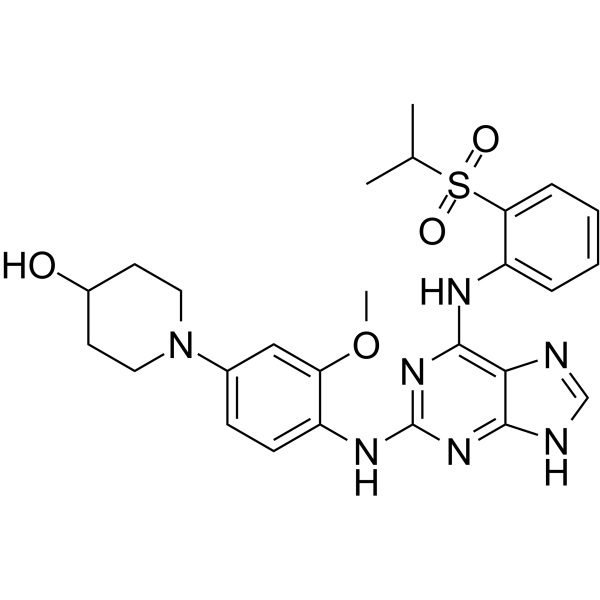| Cas No.: | 1609584-72-6 |
| Chemical Name: | Mps1-IN-3 |
| Synonyms: | Mps1-IN-3;1-(4-((6-((2-(isopropylsulfonyl)phenyl)amino)-9H-purin-2-yl)amino)-3-methoxyphenyl)piperidin-4-ol;AOB4999;SYN5205;BDBM50512457;COc1cc(ccc1Nc1nc(Nc2ccccc2S(=O)(=O)C(C)C)c2[nH]cnc2n1)N1CCC(O)CC1;1-[3-methoxy-4-[[6-(2-propan-2-ylsulfonylanilino)-7H-purin-2-yl]amino]phenyl]piperidin-4-ol |
| SMILES: | S(C1=C([H])C([H])=C([H])C([H])=C1N([H])C1C2=C(N=C([H])N2[H])N=C(N=1)N([H])C1C([H])=C([H])C(=C([H])C=1OC([H])([H])[H])N1C([H])([H])C([H])([H])C([H])(C([H])([H])C1([H])[H])O[H])(C([H])(C([H])([H])[H])C([H])([H])[H])(=O)=O |
| Formula: | C26H31N7O4S |
| M.Wt: | 537.6338 |
| Purity: | >98% |
| Sotrage: | 2 years -20°C Powder, 2 weeks 4°C in DMSO, 6 months -80°C in DMSO |
| Description: | Mps1-IN-3 is a potent and selective MPS1 kinase inhibitor, with an IC50 of 50 nM. |
| Target: | Mps1:50 nM (IC50) |
| In Vivo: | Mps1-IN-3 (2 mg/kg, i.v.) sensitizes glioblastoma cells to vincristine in murine tumor models, with prolonged survival and no toxicity[1]. |
| In Vitro: | Mps1-IN-3 is a potent MPS1 kinase inhibitor, with an IC50 of 50 nM. Mps1-IN-3 inhibits the proliferation of U251 glioblastoma cells with an IC50 of appr 5 µM. Mps1-IN-3 (2 μM) can completely abrogates checkpoint. Furthermore, Mps1-IN-3 (5 μM) sensitizes all glioblastoma cells (U251, U87, VU147 and GBM8) to 3 nM of vincristine[1]. |
| Animal Administration: | Mice[1] Six-week old athymic female nude mice weighing about 25 g are stereotactically injected with 1 × 106 U251-FM-shCTRL or shMPS1 cells, or U251-FM, or 3 × 105 GBM8-FM cells (in 10 and 4 μL PBS, respectively) using a stereotactic instrument after drilling a small hole in the cranium of the mice. For the U251-FM-shRNA experiment, a minimum of 3 mice per group is used, and for the U251-FM and GBM8-FM cells, at least 5 mice per group are used. Tumor growth is monitored by Fluc bioluminescence imaging after injection of 150 μL D-luciferin (50 mg/mL) and imaging 10 min later for luciferase-mediated photon activity using the IVIS Lumina imaging system for the U251-FM model and the IVIS Spectrum for the GBM8-FM model. When tumors reach a size around 107 radiance for the U251 model and 5 × 105 radiance for the GBM8 model, mice are intravenously injected with vehicle, 0.5 mg/kg body weight vincristine in DMSO, and/or 2 mg/kg MPS1-IN-3 in 20% hydroxypropyl-beta-cyclodextrin (HPbetaCD), twice/week over three weeks. Tumor volume is monitored weekly by Fluc imaging[1]. |
| References: | [1]. Tannous BA, et al. Effects of the selective MPS1 inhibitor MPS1-IN-3 on glioblastoma sensitivity to antimitotic drugs. J Natl Cancer Inst. 2013 Sep 4;105(17):1322-31. |

 To enhance service speed and avoid tariff delays, we've opened a US warehouse. All US orders ship directly from our US facility.
To enhance service speed and avoid tariff delays, we've opened a US warehouse. All US orders ship directly from our US facility.




















